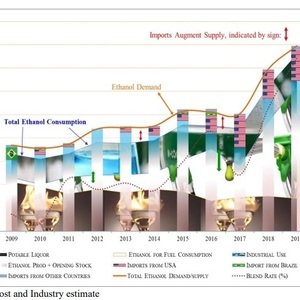Report: India to use, produce a record volume of ethanol in 2019

August 14, 2019
BY Erin Krueger
A report recently filed with the USDA Foreign Agricultural Service’s Global Agricultural Information Network shows the average ethanol blend rate in India is expected to reach a record 5.8 percent this year, up from the record of 4.1 percent set last year.
India currently aims to achieve an E10 blend by 2020 and E20 by 2030. According to the report, India’s Ethanol Blending Program stipulates procurement of ethanol produced directly from B-heavy molasses, sugarcane juice, and damaged food grains. A surplus sugar season coupled with financial incentives to convert excess sugar into ethanol is expected to help the country’s oil marketing companies (OMCs) procure more than 2.4 billion liters (634.01 million gallons) of ethanol this year.
Advertisement
Advertisement
The report indicates it is unlikely the country’s E20 goals will be reached by 2030 due to the general inability of the cane industry to supply India’s fuel demand, the fact that imports are managed in a way that minimizes the role they can play, and the expected timeframe for commercial-scale production of advanced biofuels.
India is expected to consume a record 3.8 billion liters of ethanol this year, up from a record 3.1 billion liters in 2018. The report states a 6.6 percent blend rate could be achievable if all the ethanol produced form molasses this year is blended with gasoline. “Potential blending would be higher yet if imports were permitted and duties lowered,” the report states. “However, given demand from the potable and industrial sectors and limitations on imports, a national blend average of 5.8 percent in 2019 is expected.”
Ethanol production in India is expected to reach a record 3 billion liters this year, up 11 percent from 2018. Last year, approximately 2.7 billion liters of ethanol was produced from molasses.
Advertisement
Advertisement
Regarding imports, the U.S. has remained the largest ethanol supplier to India for the past six years. Indian ethanol importers were down 14 percent last year, falling to 633 million liters. The U.S. accounted for 94 percent of 2018 imports.
According to the report, India had 166 ethanol refineries in place last year, up from 161 in 2018. That number is expected to increase this year. Nameplate capacity was 2.3 billion liters in 2018 and is expected to increase to 2.6 billion liters this year. Capacity use was 117 percent in 2018 and is expected to fall go 115 percent in 2019.
A full copy of the report can be downloaded from the USDA FAS GAIN website.
Related Stories
CARB on June 27 announced amendments to the state’s LCFS regulations will take effect beginning on July 1. The amended regulations were approved by the agency in November 2024, but implementation was delayed due to regulatory clarity issues.
SAF Magazine and the Commercial Aviation Alternative Fuels Initiative announced the preliminary agenda for the North American SAF Conference and Expo, being held Sept. 22-24 at the Minneapolis Convention Center in Minneapolis, Minnesota.
Saipem has been awarded an EPC contract by Enilive for the expansion of the company’s biorefinery in Porto Marghera, near Venice. The project will boost total nameplate capacity and enable the production of SAF.
Global digital shipbuilder Incat Crowther announced on June 11 the company has been commissioned by Los Angeles operator Catalina Express to design a new low-emission, renewable diesel-powered passenger ferry.
International Air Transport Association has announced the release of the Sustainable Aviation Fuel (SAF) Matchmaker platform, to facilitate SAF procurement between airlines and SAF producers by matching requests for SAF supply with offers.
Upcoming Events










